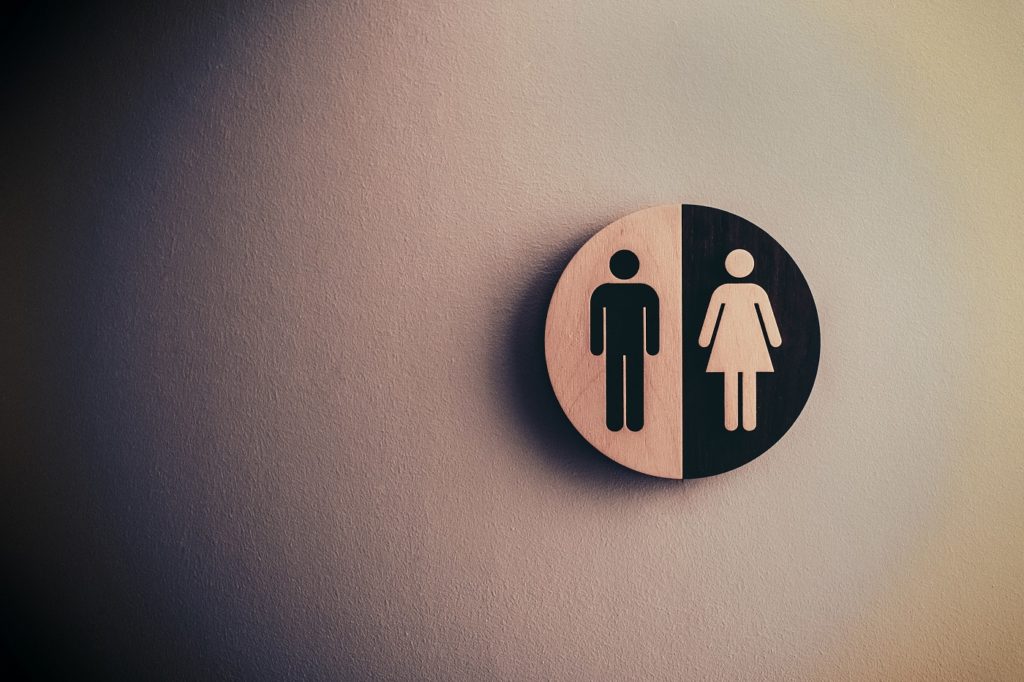Much of the recent noise surrounding transgenderism comes from debates over who gets to use which bathroom or don the ladies’ uniform. In a certain sense, this focus on sports and restrooms is important and understandable, since biology matters in both instances, and both are actionable on the policy level. But defending fairness on the field or privacy in the bathroom makes easy target practice for progressives, who shoot down such arguments as the last stand of backward bigots. Are there really hundreds of males lining up to transition just to get a competitive edge in sports? Is casting transpeople as Peeping Toms accurate or conducive to fruitful dialogue?
Saving bathrooms and athletics won’t accomplish much in the long run if what it means to be embodied beings as male and female has already been forgotten. Unfortunately, gaining a hearing on these more fundamental questions of embodiment and purpose is nearly impossible in the contemporary political and media realms. That makes it even more important for individuals, families, and communities of faith to embrace, treasure, and live in the messy, yet wonderful, reality of being male and female.
It’s also essential to know the why behind such beliefs and practices. We should be ready to counter the frequent claim that traditional ideas can only be attributed to irrational bias against those who identify as LGBT. If the opportunity for meaningful dialogue beyond bathrooms and sports policy actually materializes, we should make sure that we can offer compelling answers as to what our bodies are actually for.
Saving bathrooms and athletics won’t accomplish much in the long run if what it means to be embodied beings as male and female has already been forgotten.
Start your day with Public Discourse
Sign up and get our daily essays sent straight to your inbox.Competing Rights and Claims of Animus
Transgender controversies usually end in a stalemate, with progressives and conservatives stuck in a war of wills over individual rights. Progressives prioritize the therapeutic rights of personal self-expression in their attempt to avoid dignitary harm and implement “gender-affirming” care. Conservatives, on the other hand, prioritize the legal rights of biologically male and female majorities in sex-specific spaces and the religious rights of those who conscientiously object to gender ideology. This conservative position can easily seem unloving toward transgender individuals, portraying transgender people as others. Furthermore, the focus on “my rights” over “their rights” lends credence to the animus concept central to the Supreme Court’s rulings on LGBT issues since at least Romer v. Evans in 1996.
Consider Senator Dick Durbin’s closing remarks in the recent Senate Judiciary Committee hearing on the Equality Act. Downplaying concerns about bathrooms and women’s sports, Durbin stated, “We are waiting for this avalanche of problems . . . but they haven’t really surfaced.” Presenting claims of “religious liberty” as a cover for discrimination, Durbin concluded,
I do believe that people who want to blatantly discriminate and use religion as their weapon have gone too far. We have to have limits on what they can do. I might remind us in history that the Ku Klux Klan was not burning question marks. They were burning a cross. They were making some distorted connection with religion. And God forbid that anybody would buy that. We don’t need that in America, regardless of the time, regardless of the organization, wherever they come down on the political spectrum.
Durbin’s commentary demonstrates that focusing on bathrooms, sports, and religious liberty cedes too much ground. It simply reinforces the irrational animus claim that conservatives are trying to retain the right to be bigots. In this process, the crucial questions of what really constitutes human identity and design are sidestepped. Maybe the irrational animus claims stick because we haven’t clearly articulated the core issues with transgenderism, nor have we offered a convincing alternative.
Gender Goes Beyond Mere Performance
Transgenderism is an outworking of the mind/body dualism that pervades modern thinking. As Houston Baptist University professor Nancy Pearcey argues in her 2019 book, Love Thy Body, this framework leads to a fragmented view of human beings. By treating “the body as extrinsic to the person” the autonomous self can impose its own interpretations on the physical body. Pearcey explains that this is the core problem of personhood theory: a two-tiered view of human beings, where the human person is defined as the authentic self, constituted in the mind, while the body is relegated to a secondary position with no intrinsic meaning.
Within the dualistic framework of contemporary gender ideology, the mind’s internal sense of gender identity takes primacy over the body to the point of bending, modifying, or mutilating physical reality to one’s own will. In such a system, gender is not tied in any meaningful sense to the body. Rather, it is a social construct defined by behaviors, attitudes, and practices that are enacted or performed as one chooses.
But all of this doesn’t add up. If gender identity is totally independent of one’s biological sex, why rush to change one’s body to align with a subjective internal identity? And furthermore, if one’s gender identity is really so free and unbounded, why is it so uncreatively bound up with old gender stereotypes? If a girl likes rough-and-tumble games and hopes to work with her hands, why do people think she really is a boy? Why does she then have to change her appearance to look like a boy based on gender stereotypes if the stereotypes are based on a faulty binary? When Bruce Jenner said “call me Caitlyn,” why was the big photo shoot reminiscent of a pin-up model session perpetuating further objectification of women?
For a movement that claims to move beyond the binary, it seems quite intent on doubling down on gender stereotypes and seems unavoidably tied to the stubborn reality that gender is physically embodied in a person. Ironically, the transgender person’s desire to have his or her body and mind align is a sideways confession of the truth that our bodies are central to our identity and that we long for congruence between our physicality and mentality.
Behold, the Mysterious Gift of Our Bodies
Thankfully, there is an alternative to gender ideology’s discordant dualism. When gendered embodiment is treasured, maleness and femaleness are understood not as acts we perform, but as our very bodily essence. Being a man or a woman is not simply what one does, it is who one is. This releases men and women from unhealthy and unrealistic gender stereotypes, past or present.
Men, whether they like flowers or towers, are really, ontologically men, and they can live out their body’s teleology as those who are strong enough to self-give, sacrifice, and provide. Women, whether they lift weights or plates, are really, truly women, and can embrace their body’s inherent generative potency as the closest things to divine creators on the planet.
When we understand that our bodies have purpose and are central to our identity, we find a better way. Our bodies become gifts, as does all of life. With gift as the working principle, men and women sacrificially give in complementary ways, not in order to perform certain roles or score points, but because such actions express and embody who we are. As St. John Paul II explained so elegantly, “The human body includes right from the beginning . . . the capacity of expressing love, that love in which the person becomes a gift—and by means of this gift—fulfills the meaning of his being and existence.”
Male–female differences are not performative acts, nor are they biological accidents. They reveal something profound about what it means to be human. This is reflected in any relationship, but especially in the self-giving gift of marital love, which profoundly expresses and intimately engages male–female embodiment and births new life. Such holistic convergence of mind and body brings husband and wife further outside of themselves through the loving work of child-rearing. To be sure, this is a path of sacrifice. But embracing our embodiment in relation to others in the context of family and community offers more lasting meaning than professed liberation from these so-called limits.
In a world of gender questions and confusion, the gift of sexed bodies and their familial telos is profoundly counter-cultural—and deeply compelling. Unbounded sexual and gender choice sounds freeing, but it provides no framework for meaningful action in the world, for it deconstructs too much. We are called to embrace the richer, original diversity of male and female as truly liberating, beautiful, and wonderfully erotic. There is unending awe and mystery in this exploration of the original other.
It’s time to move beyond the plastic constructions and distorted shadows of our present age and into the real, fleshy, and messy world of manhood and womanhood. We can do more than “just say no” to gender ideology trumpeted by media, politics, and celebrity. We can do more than make a last stand for bathrooms and sports fields. We can offer something better: the mysterious gift of male and female embodiment, with its inherent meaning and destiny.














